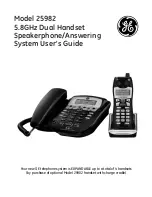
Active Antenna Distribution
(3 or more receivers)
If distribution is needed for more than two systems,
an active antenna distribution system is recommended.
Active splitters require power to operate, but provide
make-up gain to compensate for the additional losses
resulting from multiple splits off the same antennas.
A typical active system will have 4-5 antenna outputs.
Many active antenna distribution systems will provide
power distribution to the receivers as well. Multiple active
distribution systems can be used together if more outputs
are needed, but this must be done carefully. A theoretically
perfect distribution system would provide unity gain from
input to output. In practice, the antenna outputs of an
active system may have as much as 1.5 - 2 dB of gain.
Over-amplification of the radio signal can cause unwanted
side effects, such as aggravated intermodulation products
and increased radio “noise”. To prevent these problems,
it is strongly recommended to not cascade antenna
distribution systems more than two deep. A better method
is to use a “master” antenna distribution system to split
the signal to a second tier of “slave” distribution systems.
All receivers are then connected to either the “master”
or “slave” distribution systems. Connecting receivers in
this manner keeps all the receivers closer to the pure
antenna signal.
Pay attention to the frequency bandwidth specified
for the antenna distribution system. They are typically
available in both wideband and narrowband varieties.
Wideband refers to a device that will pass frequencies
over a large range, typically several hundred Megahertz.
“Narrowband” devices may be limited to no more
than 20 or 30 MHz. Since these are active devices,
frequencies outside the bandwidth of the distribution
system will not pass on to the receivers.
ANTENNA REMOTING
As mentioned before, some installations require that
the antennas be removed from the receiver chassis and
placed in another location to ensure better line-of-sight
operation. Antennas can be placed outside of the rack on
microphone stands, wall brackets, or any other suitable
mounting device. As discussed before, receivers may
come supplied with either 1/4-wave or 1/2-wave antennas.
The 1/4-wave antennas rely on the receiver chassis to
maintain a ground plane, without which they lose their
effectiveness. Therefore, 1/2-wave antennas must be used
when remote-installing antennas. They do not require the
ground plane supplied by the receiver. Directional antennas
are obviously designed to be remote-mounted as well.
Because of RF loss issues in coaxial cables, it is
important to use the proper low loss coaxial cable. 50 ohm
low loss cable is typically used in wireless microphone
applications. Using 75 ohm cable results in additional loss
due to the impedance mismatch, but this may not be fatal
to the installation, since this loss is typically less than 1 dB.
Cable specifications from any manufacturer should list
a cable's attenuation (loss) at various frequencies in dB
8
ANTENNA SETUP
Wireless Systems Guide for
Antenna distribution: 4 receivers
Antenna distribution: 8 receivers (master/slave)
Summary:
• 2 receivers = passive antenna splitter
• 4 - 5 receivers = active antenna distribution
systems
• More than 5 receivers = multiple active
systems connected in a “master/slave”
arrangement
Summary of Contents for ANTENNA SETUP
Page 2: ......





































